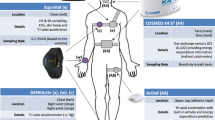Abstract
Supporting older people, many of whom live with chronic conditions, cognitive and physical impairments to live independently at home is of increasing importance due to ageing demographicssss. To aid independent living at home, much effort is being directed at reliably detecting activities from sensor data to monitor people’s quality of life or to enhance self-management of their own health. Current efforts typically leverage large numbers of sensors to overcome challenges in the accurate detection of activities. In this work, we report on the results of machine learning models based on data collected with a small number of low-cost, off-the-shelf passive sensors that were retrofitted in real homes, some with more than a single occupant. Models were developed from sensor data to recognize activities of daily living, such as eating and dressing as well as meaningful activities, such as reading a book and socializing. We found that a Recurrent Neural Network was most accurate in recognizing activities. However, many activities remain difficult to detect, in particular meaningful activities, which are characterized by high levels of individual personalization.
Access this chapter
Tax calculation will be finalised at checkout
Purchases are for personal use only
Similar content being viewed by others
References
Majumder, S., et al.: Smart homes for elderly healthcare—recent advances and research challenges. Sensors 17, 2496 (2017)
Wallace, M., Mary, S.: Katz index of independence in activities of daily living (ADL). Urologic Nursing J. 27(1), 93–94 (2007)
NICE. Mental wellbeing of older people in care homes (2013) [Online]
Civitarese, G., Belfiore, S., Bettini, C.: Let the objects tell what you are doing. In: The ACM International Joint Conference on Pervasive and Ubiquitous Computing, Heidelberg, Germany (2016)
Niu, L., Saiki, S., Bousquet, L.D., Nakamura, M.: Recognizing ADLs based on non-intrusive environmental sensing and BLE beacons. In: 8th International Conference on Indoor Positioning and Indoor Navigation, Sapporo, Japan (2017)
InfluxDB. InfluxDB: Purpose-Built Open Source Time Series Database. https://www.influxdata.com/. Accessed 12 Apr 2020
Home-Assistant. Home Assistant. https://home-assistant.io. Accessed 21 Sep 2019
Wonderapps. ATracker - Daily Task and Time Tracking. https://www.wonderapps.se/atracker/home.html. Accessed 19 Mar 2020
Author information
Authors and Affiliations
Corresponding author
Editor information
Editors and Affiliations
Rights and permissions
Copyright information
© 2021 Springer Nature Switzerland AG
About this paper
Cite this paper
O’Sullivan, D., Basaru, R., Stumpf, S., Maiden, N. (2021). Monitoring Quality of Life Indicators at Home from Sparse, and Low-Cost Sensor Data. In: Tucker, A., Henriques Abreu, P., Cardoso, J., Pereira Rodrigues, P., Riaño, D. (eds) Artificial Intelligence in Medicine. AIME 2021. Lecture Notes in Computer Science(), vol 12721. Springer, Cham. https://doi.org/10.1007/978-3-030-77211-6_17
Download citation
DOI: https://doi.org/10.1007/978-3-030-77211-6_17
Published:
Publisher Name: Springer, Cham
Print ISBN: 978-3-030-77210-9
Online ISBN: 978-3-030-77211-6
eBook Packages: Computer ScienceComputer Science (R0)




